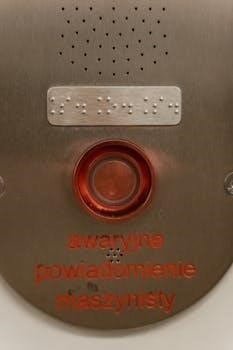Pneumatic System Symbols PDF⁚ A Comprehensive Guide
This comprehensive guide provides a detailed overview of pneumatic system symbols‚ essential for anyone working with pneumatic circuits. It covers standardized symbols according to ISO 1219-1. The guide helps in understanding and interpreting diagrams‚ facilitating efficient design‚ maintenance‚ and troubleshooting of pneumatic systems‚ with practical examples.

Pneumatic systems rely on compressed air to transmit power and control various mechanical operations. Understanding these systems requires familiarity with pneumatic symbols‚ which are standardized graphical representations of components used in pneumatic circuits. These symbols offer a universal language for engineers‚ technicians‚ and designers‚ ensuring clear communication and accurate interpretation of system schematics. Pneumatic symbols are not arbitrary; they adhere to specific conventions‚ primarily defined by ISO 1219-1‚ ensuring consistency and clarity across different regions and industries.
This section introduces the fundamental concepts of pneumatic symbols‚ highlighting their importance in designing‚ analyzing‚ and maintaining pneumatic systems. We will explore the basic shapes and their meanings‚ demonstrating how they represent different valves‚ actuators‚ and other essential components. By understanding the basics‚ readers can quickly grasp the function of each component and how they interact within a pneumatic circuit. These symbols minimize design errors.

ISO 1219-1 Standard for Pneumatic Symbols
The ISO 1219-1 standard is the cornerstone of pneumatic symbol standardization‚ providing a comprehensive set of guidelines for representing pneumatic components in circuit diagrams. This international standard ensures that symbols are universally recognized and understood‚ facilitating effective communication among engineers and technicians worldwide. ISO 1219-1 covers a wide range of components‚ including valves‚ actuators‚ pressure regulators‚ and air preparation units‚ each with its distinct graphical representation. This standardization minimizes ambiguity and reduces the likelihood of errors in system design and maintenance.
The standard also specifies rules for combining basic symbols to create more complex representations of integrated components. By adhering to ISO 1219-1‚ pneumatic circuit diagrams become easier to interpret‚ simplifying troubleshooting and ensuring that systems are built and maintained correctly. This section delves into the specifics of the ISO 1219-1 standard‚ exploring its key principles and providing examples of how it is applied in practice. It is used through catalog and on the labels.
Basic Pneumatic Symbols⁚ An Overview
Understanding the basic pneumatic symbols is fundamental to interpreting pneumatic circuit diagrams effectively. These symbols represent the core components that make up a pneumatic system‚ such as cylinders‚ valves‚ and air preparation units. Each symbol is designed to convey the component’s function and how it interacts within the circuit. For example‚ a simple rectangle might represent a cylinder‚ while different valve types have distinct symbols indicating their number of ports and positions.
Flow lines‚ depicted as solid lines‚ show the path of compressed air‚ while dashed lines often indicate pilot or control lines. Learning these basic symbols allows engineers and technicians to quickly grasp the layout and operation of a pneumatic system. This overview provides a foundation for understanding more complex symbols and circuit diagrams‚ enabling efficient design‚ troubleshooting‚ and maintenance of pneumatic systems. Mastering these symbols streamlines communication and reduces errors in pneumatic system development. By knowing these symbols‚ you will improve the design and solving of pneumatic systems.
Symbols for Valves in Pneumatic Systems

Valves are critical components in pneumatic systems‚ and their symbols are essential for understanding circuit diagrams. Each valve symbol indicates the number of ports and positions. Ports are represented as connection points‚ while positions show the valve’s different states. A 3/2 valve‚ for example‚ has three ports and two positions‚ often depicted using squares.
The arrows within these squares indicate the direction of airflow in each position. Actuation methods‚ such as manual‚ pneumatic‚ or solenoid‚ are also shown‚ often with additional symbols attached to the valve symbol. These symbols are standardized to ensure clarity and consistency across different diagrams. Directional control valves are a vital part of pneumatic control.
Understanding these symbols allows one to quickly determine the valve’s function and its role in the circuit. Correctly identifying valve symbols is essential for troubleshooting and maintaining pneumatic systems‚ ensuring proper operation and reducing downtime. By recognizing the nuances of each symbol‚ technicians and engineers can accurately interpret circuit diagrams and effectively diagnose issues within the system.
Symbols for Actuators in Pneumatic Systems
Actuators‚ which convert pneumatic energy into mechanical motion‚ are represented by distinct symbols. Cylinders‚ a common type of actuator‚ are typically depicted as a rectangle with a piston rod extending from one end. The type of cylinder‚ whether single-acting or double-acting‚ is indicated by the presence of one or two ports. A single-acting cylinder has one port and relies on a spring for retraction‚ while a double-acting cylinder has two ports for both extension and retraction.
The symbols also indicate the presence of cushions‚ which are used to slow down the piston at the end of its stroke; Rotary actuators‚ which produce rotational motion‚ are represented by a circle with an arrow indicating the direction of rotation. Understanding these symbols is crucial for interpreting pneumatic circuit diagrams.
These symbols provide essential information about the actuator’s function and operation. Correctly identifying actuator symbols ensures that the system is properly designed and maintained‚ and enables efficient troubleshooting and repair of pneumatic systems.
Symbols for Air Preparation Units
Air preparation units play a vital role in ensuring the quality and reliability of pneumatic systems. These units condition the compressed air by filtering out contaminants‚ regulating pressure‚ and adding lubrication; The symbols for air preparation units are essential for understanding the function of these components within a pneumatic circuit.
A filter is typically represented by a diamond shape with an arrow indicating the direction of airflow. A pressure regulator is symbolized by a circle with an arrow pointing towards a line‚ indicating the regulation of pressure. Lubricators are often depicted as a circle with a drop of oil inside‚ signifying the addition of lubrication to the air stream.
Combinations of these components‚ such as filter-regulator units‚ are represented by combining the individual symbols. These symbols help in identifying and understanding the role of each component in maintaining clean‚ regulated‚ and lubricated air for optimal pneumatic system performance. Proper air preparation extends the life of pneumatic components and reduces downtime.
Understanding Flow Lines and Connections
Flow lines and connections are crucial elements in pneumatic circuit diagrams‚ representing the pathways through which compressed air travels. Understanding these symbols is essential for interpreting how different components are interconnected and how the system functions as a whole. Flow lines are typically depicted as solid lines‚ indicating the main paths of airflow.
Different types of lines represent different connections. A solid line represents a working line‚ while a dashed line often indicates a pilot or control line. Connections between components are shown by the intersection of these lines‚ with dots sometimes used to clarify that a connection exists.
Understanding the direction of airflow is critical‚ and arrows are used to indicate this direction within the flow lines. These arrows are usually placed along the lines‚ showing the path the air takes as it moves through the system. By correctly interpreting flow lines and connections‚ one can trace the sequence of operations in a pneumatic circuit.
Reading Pneumatic Circuit Diagrams
Pneumatic circuit diagrams are graphical representations of pneumatic systems‚ utilizing standardized symbols to depict components and their interconnections. Effectively reading these diagrams is crucial for designing‚ troubleshooting‚ and maintaining pneumatic systems. Each symbol represents a specific component‚ such as valves‚ actuators‚ or air preparation units‚ allowing for a clear understanding of the system’s layout and function.
To read a pneumatic circuit diagram‚ start by identifying the key components using their respective symbols. Then‚ trace the flow lines to understand how these components are connected and how air is directed through the system. The direction of airflow is indicated by arrows along the flow lines.
Understanding the function of each component‚ as indicated by its symbol‚ is essential for interpreting the diagram. Additionally‚ pay attention to any labels or annotations that provide further information about the components or their settings. By systematically analyzing the symbols and connections‚ one can gain a comprehensive understanding of the pneumatic circuit’s operation.
Pneumatic Symbol Libraries and Resources
To facilitate the creation and interpretation of pneumatic circuit diagrams‚ several symbol libraries and resources are available. These resources offer a comprehensive collection of standardized pneumatic symbols‚ ensuring consistency and accuracy in diagramming. Pneumatic symbol libraries often come in various formats‚ such as PDF‚ DXF‚ and DWG‚ allowing for easy integration into CAD software and other design tools.
These libraries typically include symbols for a wide range of pneumatic components‚ including valves‚ cylinders‚ actuators‚ air preparation units‚ and more. Each symbol is designed to conform to industry standards‚ such as ISO 1219-1‚ ensuring compatibility and clarity.
In addition to symbol libraries‚ online resources such as manufacturers’ websites‚ educational platforms‚ and industry forums provide valuable information on pneumatic symbols and their applications. These resources may offer tutorials‚ examples‚ and best practices for creating and interpreting pneumatic circuit diagrams. Accessing these libraries and resources can significantly enhance one’s ability to work with pneumatic systems effectively.
Benefits of Using Standardized Pneumatic Symbols
Using standardized pneumatic symbols offers numerous advantages in the design‚ maintenance‚ and troubleshooting of pneumatic systems. Standardization ensures clarity and consistency in circuit diagrams‚ minimizing ambiguity and reducing the risk of errors. By adhering to recognized standards like ISO 1219-1‚ engineers‚ technicians‚ and other professionals can easily understand and interpret diagrams‚ regardless of their origin.
Standardized symbols facilitate effective communication among different teams and departments involved in a project. Clear and consistent diagrams promote collaboration and reduce misunderstandings‚ leading to improved efficiency and productivity. Moreover‚ standardized symbols simplify training and education‚ enabling individuals to quickly learn and apply pneumatic principles.
Furthermore‚ using standardized symbols enhances the maintainability and serviceability of pneumatic systems. Technicians can quickly identify components and their functions‚ facilitating troubleshooting and repairs. This reduces downtime and minimizes costs associated with maintenance. In summary‚ the adoption of standardized pneumatic symbols is crucial for ensuring accuracy‚ efficiency‚ and effective communication in all aspects of pneumatic system design and operation.

